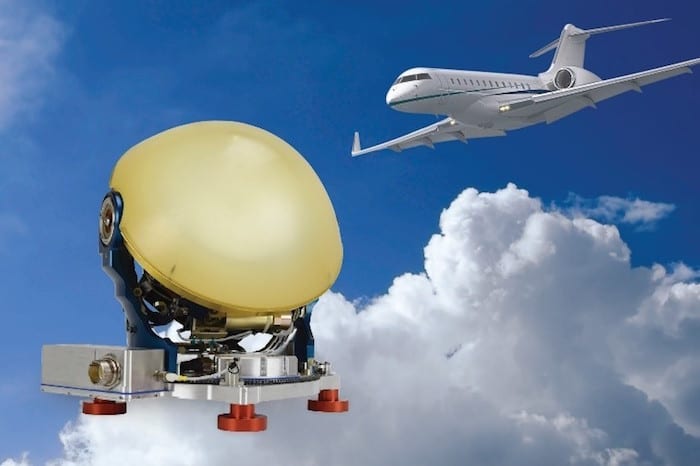
Astronics AeroSat is introducing its next generation of tail-mounted satcom antenna systems for Intelsat’s new FlexExec service. Image courtesy of Astronics Corp.
A new partnership between Astronics, Intelsat and Satcom Direct (SD) will bring the first satellite-based high-speed connectivity service with capacity completely dedicated to business aviation operators.
FlexExec, Intelsat’s new Ku-band satellite internet service for business jets, was unveiled by the three partners at the 2018 National Business Aviation Association (NBAA) annual conference and exhibition Oct. 15 in Orlando, Florida. The service is enabled by Intelsat’s Epic high-throughput satellite (HTS) network. The Luxembourg-based communications satellite services provider finished launching that last of its six Epic satellites Oct. 1.
Astronics is providing its tail-mounted antenna system, AeroSat FlightStream T-310, to enable the new service. Along with the T-310, operators will also need to equip with the next-generation iDirect CX780 modem, which is compatible with both Ku-band wide beam and HTS networks. The T-310 is also capable of providing voice-over-IP (VoIP) telephony and streaming internet television (IPTV).
Mark Rasmussen, VP and general manager of mobility for Intelsat, described to Avionics International how he feels the new service is unrivaled in its uniqueness for business aviation operators.
“It combines the power of our Ku eco system to include our six Epic HTS satellites and the rest of our total fleet of over 50 satellites, many of which designed specifically for mobility to provide global coverage,” he said. “What we’re able to do with Epic is lay down enormous amounts of throughput where traffic is highest. It is bringing layers of coverage, multiple satellites covering the earth, and multiple beams and high throughput in high traffic areas.”
The service also does not share any satellite capacity with Intelsat’s commercial airline or consumer broadband customers. It facilitates a 10-megabit-per-second connection to the aircraft, enough to enable simultaneous livestreaming on passenger and pilot devices.
A live demonstration of the new service on a Gulfstream aircraft following a press conference allowed five different mobile devices to simultaneously stream live television, Netflix and FaceTime on an iPhone. While the demonstration occurred on the ground, SD has been flight testing the new service since July 2018, focusing on stress-testing it with simultaneous streaming.
Another major differentiator included in the FlexExec service is what SD CEO Jim Jensen describes as “power by the hour” connectivity.
“A lot of other services position their [business models] within committed information rates. If you want 10 megabits, you’ll pay for 10. If you want five, you pay for five,” Jensen said during a joint press conference with Intelsat. “What we do is you pay for the complete availability of the network, and at the moment we think 10 megabits is a good experience. We plan on taking that up to 25 in the next year — we already know Intelsat has enough capacity.”
Jensen also described how SD can use its “FlightDeck Freedom (FDF)” communications platform to customize the way pilots will use FlexExec connectivity. FDF uses a combination of datalink and software to allow pilots to designate who is authorized to send messages and emails to the aircraft, perform calculations for runway analysis and even integrate automated flight route alerts within existing avionics displays about hazardous conditions within the aircraft’s flight path.
Both Jensen and Rasmussen described how they address cybersecurity concerns associated with connected cockpit applications as well as for passenger devices. According to Rasmussen, Intelsat is the industry’s only satellite services provider with a service organization control 3 (SOC-3) compliance. SOC-3-compliant organizations adhere to independently administered audits that assess internal controls for security, availability, processing integrity, confidentiality or privacy.
On its end, SD uses a cybersecurity module that exists within its SD Pro software as a service platform. The module interfaces all internet traffic occurring over its various networks with its global data infrastructure where engineers constantly monitor the network for security risks.
“In the last six months months throughout 988 flights, 456 malwares have been blocked,” said Jensen.
Intelsat and SD are targeting the first quarter of 2019 for the first supplemental type certification (STC) for FlexExec.